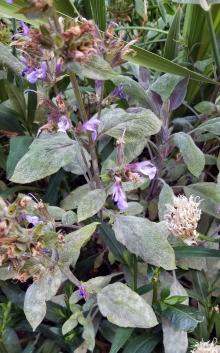Cause The fungus Neoerysiphe galeopsidis has been reported from Washington and powdery mildew has been observed in Oregon on Lamb's ear plants. Although plants do not die, the conspicuous disease signs detracted significantly from the appearance of the infected plants.
Symptoms Obvious white-to-grayish patches of mycelia on both leaf surfaces and stems. Colonies are at first scattered in early summer but can quickly cover entire leaves. Leaves are normally heavily covered with long, soft trichomes that give it a silvery sheen but powdery mildew colonies can be seen below on the surface of the leaf.
Cultural control
- Space plants for good air circulation.
Chemical control There are no fungicides specifically labeled for this disease on this crop. However, several group 3, 7, 11, M2 and possibly horticultural or botanical oils may be effective if not phytotoxic. Addition of a spreader may be necessary to adequately wet these hairy leaves.
Reference Glawe, D. A., and Koike, S.T. 2007. First report of powdery mildew of Stachys byzantina (lamb's ear) caused by Neoerysiphe galeopsidis in North America. Plant Health Progress, 8:36. doi:10.1094/PHP-2007-1217-01-BR.


